| home | De site | De subsidieregeling | Initiatiefnemers | Participerende bedrijven | Contact | Wetsalt in de pers | |||
Participerende bedrijven De volgende bedrijven zullen binnenkort hun technologie op de site demonstreren.
Dutch Rainmaker 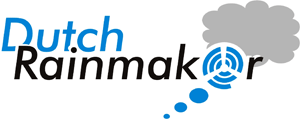 Met de Dutch Rainmaker kan effectief, ook voor kleinschalige toepassingen, water uit lucht of zoet water uit zout water geproduceerd worden. Voor de water uit lucht versie (A/W versie) wordt gebruik gemaakt van de natuurlijke aanwezige vochtigheidsgraad in lucht. Door de lucht af te koelen zal condensatie optreden van de waterdamp. Dit condensaat zal in de vorm van druppels worden opgevangen en kan worden gebruikt als drink- en irrigatiewater. Uniek aan het concept is dat dit warmte-koudeproces rechtstreeks zal worden aangedreven door een windmolen die in dit geval dus geen elektriciteit produceert maar water. Parallel aan de ontwikkeling van de A/W variant ontwikkelt Dutch Rainmaker ook het systeem dat brak, zout of vervuild water kan zuiveren tot schoon zoet water (W/W versie). De basis van deze technologie is eveneens gebaseerd op het hierboven omschreven koude warmte proces. Voor beide concepten betreft het een stand-alone toepassing die zonder verdere benodigde infrastructuur kan opereren en honderden gezinnen van water kan voorzien op basis van duurzame energie. Op de researchsite van Wetsalt zal Dutch Rainmaker de eerste demo-/proefinstallatie ontwikkelen en demonstreren. De proefinstallatie heeft een beoogde waterproductiecapaciteit van 0,5-1 m³ (A/W versie) tot 10-15 m³ (W/W versie) per dag. Informatie over Dutch Rainmaker en de technologie vindt u hier(pdf). Redstack  REDstack BV is het eerste spin-off bedrijf van WETSUS en richt zich op het ontwikkelen, opschalen en vermarkten van de R.E.D.-technologie. Technology The main method for generating blue energy with membranes is Reverse Electro Dialysis (RED). RED utilizes the electro potential arising when ion-selective permeable membranes separate electrolyte solutions of different concentrations. Two types of membranes are used in this system; one is cation exchange membrane (CEM) and another is anion exchange membrane (AEM). These two ion exchange membranes can separate positive and negative ions and then generate electricity. Power generation by mixing seawater and river water in this advanced way has no fuel costs and no emissions except brackish water. In the old days, membrane technology was not sufficiently advanced, so high expense on membranes embarrassed the scientists to do further research. But at present, the problem of RED's economical feasibility is supposed to be solved because recent developments show costs for membranes can be reduced considerable. 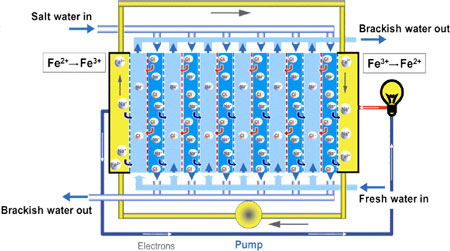 Voltea 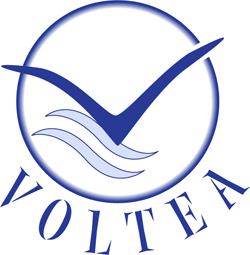 Voltea is recent opgericht (in 2007) als dochteronderneming van Unilever om een efficiente en milieuvriendelijke de-ionisatie technologie te ontwikkelen om water te zuiveren en te onderharden in Europa en India. Deze technologie is capacatieve deionisatie. Flow Through Capacitor Capacitive Deionization (CD) is an innovative technology for removing salts from water. The technique is compatible with proved technologies like Reversed Osmosis. The CD principle is used in a Flow Through Capacitor system (FTC). The FTC system consists of two oppositely charged electrodes and anionic and cationic membranes. When salt (for example CaCl2) flows into the FTC cell, the ions move through the membranes to the oppositely charged electrodes. Desalinated water leaves the FTC cell. See pictures below. 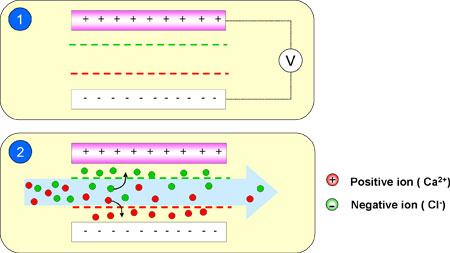 As soon as the surface of both electrodes is saturated with ions the electrodes can be regenerated by reversing the polarity of the electrodes so that a concentrated brine is formed between both membranes. The concentrated brine then is removed from the cell. See pictures below. 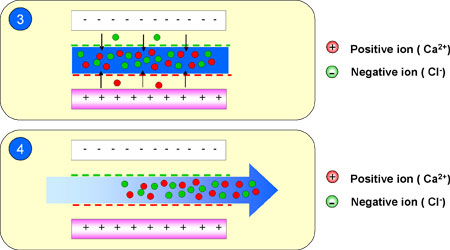 The polarity of the electrodes will be reversed to normal and the cell is ready to use again. The FTC consist of multiple layered cells. AquaExplorer  AquaExplorer is een jong en snel groeiend bedrijf wat zich richt op het aanbieden van totaal-oplossingen (total solutions) binnen het gebied van watermanagement. AquaExplorer beschikt over een groot research and development team, gecombineerd met een brede productkennis en watertechnologie. Naast R&D en advisering richt het bedrijf zich op participatie en partnerschap hetgeen resulteert in optimaal watermanagement. Het portfolio van AquaExplorer varieert van klantspecifieke projecten tot aan total solutions voor elk water gerelateerd onderwerp. Op de site van Wetsalt doet AquaExplorer onderzoek naar de technologie van Mechanische Damp Recompressie. Mechanical Vapor Recompression (MVR) is one of the most energy efficient evaporation systems. MVR is a technique in which the major heating source is the vapor. It picks up energy when being compressed to higher pressure and temperature. On condensation the energy of the vapor is transferred in a heat exchanger to the saline fluid stream. Therefore the heat in the system is constantly reused. The brine stream is recirculated at a relatively high rate. With power being the only utility, the major operating expense of a MVR system is the mechanical energy required to operate the recirculation pump and the compressor. Convex and Aqua Explorer have engineered a unique system; an advanced development derived from regular Mechanical Vapor Recompression : Dynamic Vapor Recompression (DVR). Where regular MVR systems have the heat exchanging part integrated in the evaporator the DVR system has both parts separated from each other. This results in less fouling and better performance of the heat exchanger both resulting in lower energy consumption. 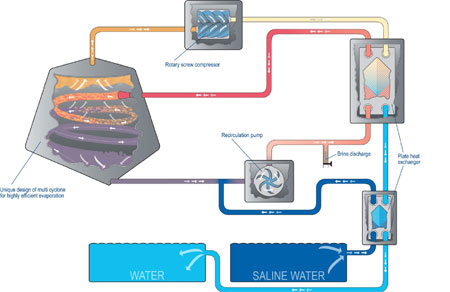 |
||||